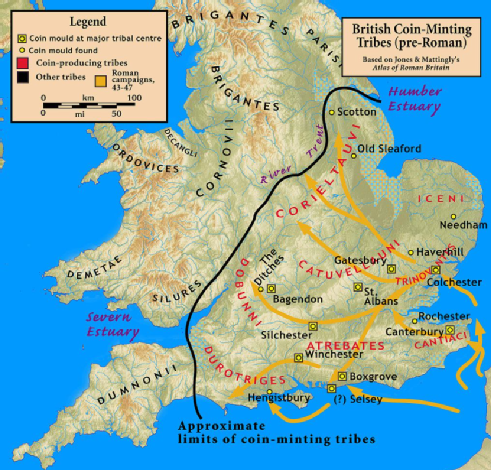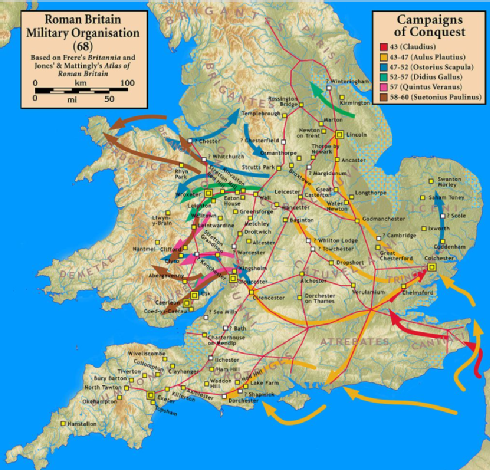The Roman Invasions of Britain

Arrival and Conquest
The Romans invaded Britain a number of times starting with Julius Caesar’s first landing in Kent in 55BC. In AD 43 the Romans once again arrived under the emperor Claudius and set about making their mark. Below you will find a quick summary of the major events with links to more information.
As will be shown, the period between the invasions of Caesar and Claudius did not constitute a 'Roman-free' period, but rather was one of growing contact, trade and a gradual spread of Roman influence and culture throughout southeast Britain and beyond.
First Invasion 55BC
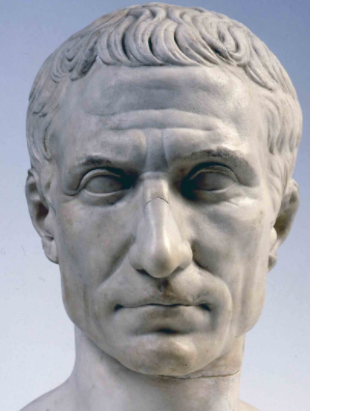
On 26th August 55BC Julius Caesar (left) set off from Gaul (France) with two legions (Legion VII and Legion X) and 500 cavalry. It is possible he meant this brief appearance as a warning or punishment for the Britons who had been aiding the Gauls in their fight against Roman rule.
With continual interactions between the Gauls and Britons, when Caesar sent out for information before his invasion it was inevitable that the Britons were forewarned. As a result some Britons sent ambassadors offering hostages and allegiance to Rome.
Commius, a chief of the Atrebates tribe from Gaul who had capitulated to Rome accompanied the ambassadors back to Britain as a negotiator, but he later had some trouble and was imprisoned by the Britons. This same Commius later joined the Gaulish resistance in 52BC and had to flee Roman occupied Gaul to Britain in 50BC where he founded a dynasty at Calleva (Silchester).
Caesar initially tried to land at Dubris (Dover), whose natural harbour had presumably been identified as a suitable landing place. However, when he came in sight of shore, the massed forces of the Britons gathered on the overlooking hills and cliffs dissuaded him from landing there, since the cliffs were so close to the shore that javelins could be thrown down from them onto anyone landing there. You can read Caesar's description in the box below.
Left is a bust of Julius Caesar, posthumous portrait in marble, 44–30 BC, Museo Pio-Clementino, Vatican Museums
The Romans probably sailed from modern day Boulogne and when unable to land at Dover carried on up the coast. It was previously thought that they landed at Walmer, but evidence now suggests that they may have sailed further to the site of modern Pegwell Bay. In Roman times the bay was part of the Wantsum Channel which split the Isle of Thanet off from the mainland.
In 2017 archaeologists from the University of Leicester found a Roman spearhead at Ebbsfleet in Thanet which may be evidence of the Roman landing. This site lies just across from Richborough which later became the ceremonial point of arrival and was the main entry point from mainland Europe. Over time Richborough developed from a military supply base into a thriving port town and later a massive fort.
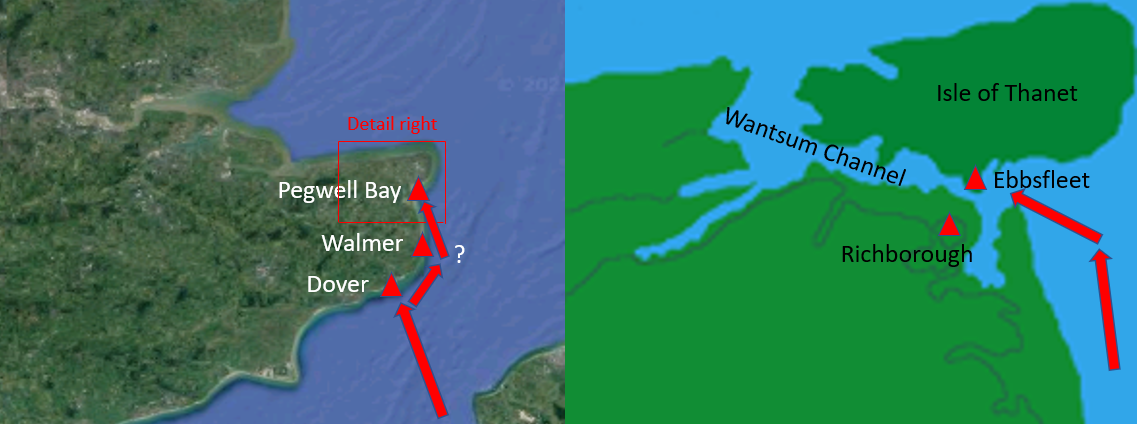
Caesar, The Gallic Wars 4.23
These matters being arranged, finding the weather favourable for his voyage, he set sail about the third watch, and ordered the horse to march forward to the further port, and there embark and follow him. As this was performed rather tardily by them, he himself reached Britain with the first squadron of ships, about the fourth hour of the day, and there saw the forces of the enemy drawn up in arms on all the hills. The nature of the place was this: the sea was confined by mountains so close to it that a dart could be thrown from their summit upon the shore. Considering this by no means a fit place for disembarking, he remained at anchor till the ninth hour, for the other ships to arrive there. Having in the mean time assembled the legates and military tribunes, he told them both what he had learned from Volusenus, and what he wished to be done; and enjoined them (as the principle of military matters, and especially as maritime affairs, which have a precipitate and uncertain action, required) that all things should be performed by them at a nod and at the instant. Having dismissed them, meeting both with wind and tide favourable at the same time, the signal being given and the anchor weighed, he advanced about seven miles from that place, and stationed his fleet over against an open and level shore.
Second Invasion 54BC
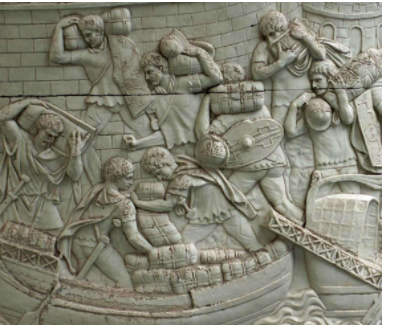 Caesar's second invasion in July 54BC was on a completely different scale, consisting of five legions and 2,000 cavalry – some 27,000 men in 800 vessels. This time the landing was unopposed, no doubt following some in depth political negotiations between the British tribes and the Romans.
Caesar's second invasion in July 54BC was on a completely different scale, consisting of five legions and 2,000 cavalry – some 27,000 men in 800 vessels. This time the landing was unopposed, no doubt following some in depth political negotiations between the British tribes and the Romans.
One of these British negotiators was Mandubracius of the Trinovantes, and enemy of Cassivellaunus of the Catuvellauni.
Cassivellaunus, a warlord from north of the Thames, had previously been at war with most of the British tribes. He had recently overthrown the king of the powerful Trinovantes and forced the king's son, Mandubracius, into exile. Mandubracius fled to the Romans and sought their help in restoring his place as head of the Trinovantes. The Trinovantes sent an embassy to the Romans agreeing to surrender to Caesar if Mandubracias was reinstated as King, providing grain and sending 40 hostages. Other tribes followed. Such affairs, argues the archaeologist Barry Cunliffe (Britain Begins, 360) were probably negotiated overwinter before the second invasion, which explains how the Romans so easily made such a rapid advance into hostile territory. Five further tribes, the Cenimagni, Segontiaci, Ancalites, Bibroci and Cassi, also went over to Rome.
Faced with the imminent invasion, the Britons appointed Cassivellaunus to lead their forces. But when Cassivellaunus realised he could not defeat Caesar in a pitched battle, he disbanded the majority of his force and relying on the mobility of his 4,000 chariots and superior knowledge of the terrain, used guerrilla tactics to slow the Roman advance. By the time Caesar reached the Thames, the one fordable place available to him had been fortified with sharpened stakes, both on the shore and under the water, and the far bank was defended. But the Romans were victorious nonetheless. In the second century AD, the historian Polyaenus recorded in his Stratagems that Caesar crossed the ford on a war elephant.
Heaving crossed the Thames, Caesar made for Cassivelaunus’ oppidum (the name for the major British settlements, especially fortified towns) and defeated them as described by Caesar himself below.
Caesar The Gallic Wars 5.21
The Trinobantes (sic) being protected and secured from any violence of the soldiers, the Cenimagni, the Segontiaci, the Ancalites, the Bibroci, and the Cassi, sending embassies, surrendered themselves to Caesar. From them he learns that the capital town of Cassivellaunus was not far from that place, and was defended by woods and morasses, and a very large number of men and of cattle had been collected in it. (Now the Britons, when they have fortified the intricate woods, in which they are wont to assemble for the purpose of avoiding the incursion of an enemy, with an intrenchment and a rampart, call them a town.) Thither he proceeds with his legions: he finds the place admirably fortified by nature and art; he, however, undertakes to attack it in two directions. The enemy, having remained only a short time, did not sustain the attack of our soldiers, and hurried away on the other side of the town. A great amount of cattle was found there, and many of the enemy were taken and slain in their flight.
At this time Cassivellaunus instructed four kings of the Cantii (or Cantiaci) in Kent - Cingetorix, Carvilius, Taximagulus and Segovax - to attack the Roman base and supply lines. This failed and Cassivellaunus had to sue for peace. Hostages were handed over along with an annual tribute, and Cassivellaunus said would leave Trinovantes in peace, under their new King Mandubracius.
Britain after Julius Caesar's Invasion - Interactions with Rome
Rather than seeing the gap between the second and third Romans invasions - between 54BC and AD43 - as one of continued isolation, it is more accurate to see this time as one of a continuation and development of ties and links with Rome; of the spread of awareness of the Roman empire, its culture and the benefits links with Rome could bring. The Roman empire was after all now visible over the channel, and links between Britain and the continent, always strong, now increased. There was even a change in pattern of trade routes favouring Gaul and Thames estuary.
With many British tribes in the southeast already sending the Romans tribute after the second invasion, there is a feeling of Britain already falling under Roman rule. How long such tribute paying lasted we don't know, but strong links were being forged between the elites of southeast Britain and Rome.
Some of the hostages given to Rome - children of the elites among the British tribes - were raised at Rome and returning to Britain brought with them Roman culture and habits. To these tribal leaders, links with Rome were increasingly seen as prestigious, bringing the benefits of trade and real or imagined cultural superiority. So rich was the interaction between southeast Britain and the Romans on the continent that in the second half of the first century BC the material culture of southeast Britain – especially Kent, Essex and Hertfordshire – became almost indistinguishable from that of Gaul north of the river Seine (Cunliffe, Britain Begins, 365) . Evidence of amphorae of wine, fine imported table ware, bronze and silver wine serving vessels is found all over the southeast. The elite seem to have been rather enjoying playing Romans.
As far as trade is concerned, the Greek geographer Strabo writes of four main trading routes in to Britain, starting from mouths of the rivers Seine, Rhine, Gironde, and Loir. The continent was becoming an even more valuable market for British surpluses under Rome. In addition, and less pleasantly, with Gaul Romanised, new areas were needed for the acquisition of slaves. And the wild north and west of Britain were good places. With captives as an increasingly valuable commodity as slaves, conflict was becoming more profitable. The Britons who Strabo described in Rome (below) may have been some of these slaves (see Cunliffe, Britain Begins, 363).
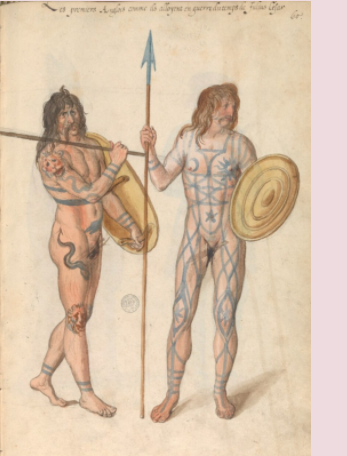
Strabo, Geography 4.5.2.
"The men of Britain are taller than the Celti, and not so yellow-haired, although their bodies are of looser build. The following is an indication of their size: I myself, in Rome, saw mere lads towering as much as half a foot above the tallest people in the city, although they were bandy-legged and presented no fair lines anywhere else in their figure. Their habits are in part like those of the Celti, but in part more simple and barbaric — so much so that, on account of their inexperience, some of them, although well supplied with milk, make no cheese; and they have no experience in gardening or other agricultural pursuits. And they have powerful chieftains in their country. For the purposes of war they use chariots for the most part, just as some of the Celti do. The forests are their cities; for they fence in a spacious circular enclosure with trees which they have felled, and in that enclosure make huts for themselves and also pen up their cattle — not, however, with the purpose of staying a long time. Their weather is more rainy than snowy; and on the days of clear sky fog prevails so long a time that throughout a whole day the sun is to be seen for only three or four hours round about midday. And this is the case also among the Morini and the Menapii and all the neighbours of the latter."
(Left) Sixteenth century perception of the first "English people" in times of the war against Julius Caesar, illustrated in the manuscript "Théâtre de tous les peuples et nations de la terre avec leurs habits et ornemens divers, tant anciens que modernes, diligemment depeints au naturel". Painted by Lucas d'Heere in the 2nd half of the 16th century.
Spheres of Influence
The sphere of strongest Roman influence was seen, naturally, in southeast Britain, with a core zone of strong Roman-influenced cultural followed by a periphery where the Dobunni and Corieltauvi – the tribes of Warwickshire – among others were located. In this peripheral zone one can imagine that the Roman cultural influence was growing, along with the consciousness that trade with their Roman near neighbours could also benefit them. In a way these tribes of the peripheral zone became middlemen, articulating the materials and manpower brought from the wilder northern and western regions.
In short, the tribes of Warwickshire were well aware of the Romans throughout the time leading up to the invasion of AD43. Culturally Roman influences cannot fail to have been growing in the region at this time, along with knowledge of the benefits that ties with Rome could bring. This goes a long way in explaining why many of the tribes in this peripheral zone capitulated willingly to Rome so soon after AD43.
But did they already think of Britain as part of Rome?
The Britons that Strabo had seen in Rome would have included not just slaves but also the hostages from the wealthy who then acquired a veneer of Romanization as stated above. Returning to their tribes and taking up leadership roles, Roman culture and influence was beginning to permeate southeast Britain and beyond. As Cunliffe states, “There was a tacit acceptance, at least by some of the major tribes of the south-east, that Britain was subservient to Rome." (Britain Begins, 363)
Certainly Strabo was of this opinion.
Strabo Geography 4.3.3.
At present, however, some of the chieftains there, after procuring the friendship of Caesar Augustus by sending embassies and by paying court to him, have not only dedicated offerings in the Capitol, but have also managed to make the whole of the island virtually Roman property.
Caligula AD39
In AD39 a Briton named Adminius son of Cunobelin fell out with his father and fled to seek the emperors help. Cunobelin controlled a substantial portion of south-eastern Britain, including the territories of the Catuvellauni and the Trinovantes, and was called "King of the Britons" (Britannorum rex) by the Roman historian Suetonius. (This is the king who Shakespeare writes about as Cymbeline). Caligula responded by preparing an invasion of Britain. He abandoned it, however, in farcical circumstances by ordering his soldiers to attack the waves and gather seashells as the spoils of victor.
How true the events are as recorded by Suetonius is unknown.
Suetonius Twelve Caesars - Caligula 46.1
Finally, as if he intended to bring the war to an end, he drew up a line of battle on the shore of the Ocean, arranging his ballistas and other artillery; and when no one knew or could imagine what he was going to do, he suddenly bade them gather shells and fill their helmets and the folds of their gowns, calling them "spoils from the Ocean, due to the Capitol and Palatine." As a monument of his victory he erected a lofty tower, from which lights were to shine at night to guide the course of ships, as from the Pharos.Then promising the soldiers a gratuity of a hundred denarii each, as if he had shown unprecedented liberality, he said, "Go your way happy; go your way rich."
Third Invasion AD43
Three years after Caligula's exhibition from the shores of Gaul, the new emperor Claudius undertook the third invasion.
The decision may have been linked to the actions of Caratacus of the Catuvellauni, whose expansion into other tribal areas and anti-Roman stance led to this reaction on the Romans' part, perhaps induced by Britons such as Verica, who exiled by Caratacus sought help from Rome. From his coinage, Verica appears to have been king of the, probably Belgic, Atrebates tribe and a descendent of the Commius who had settled at Silchester in 50BC.
In AD43 40,000 men were assembled at Gesoriacum (Boulogne), and after delays due to fear of storms by the end of AD43 the native capital of Camulodonum (Colchester) had been taken along with the core of the southeast.
The maps below show the Roman campaigns, from AD43-47 under Aulus Plautius (left) and AD43-60 under sequentially Aulus Plautius, Ostorius Scapula, Didius Gallus, Quintus Veranus and Suetonius Paulinus (right).
